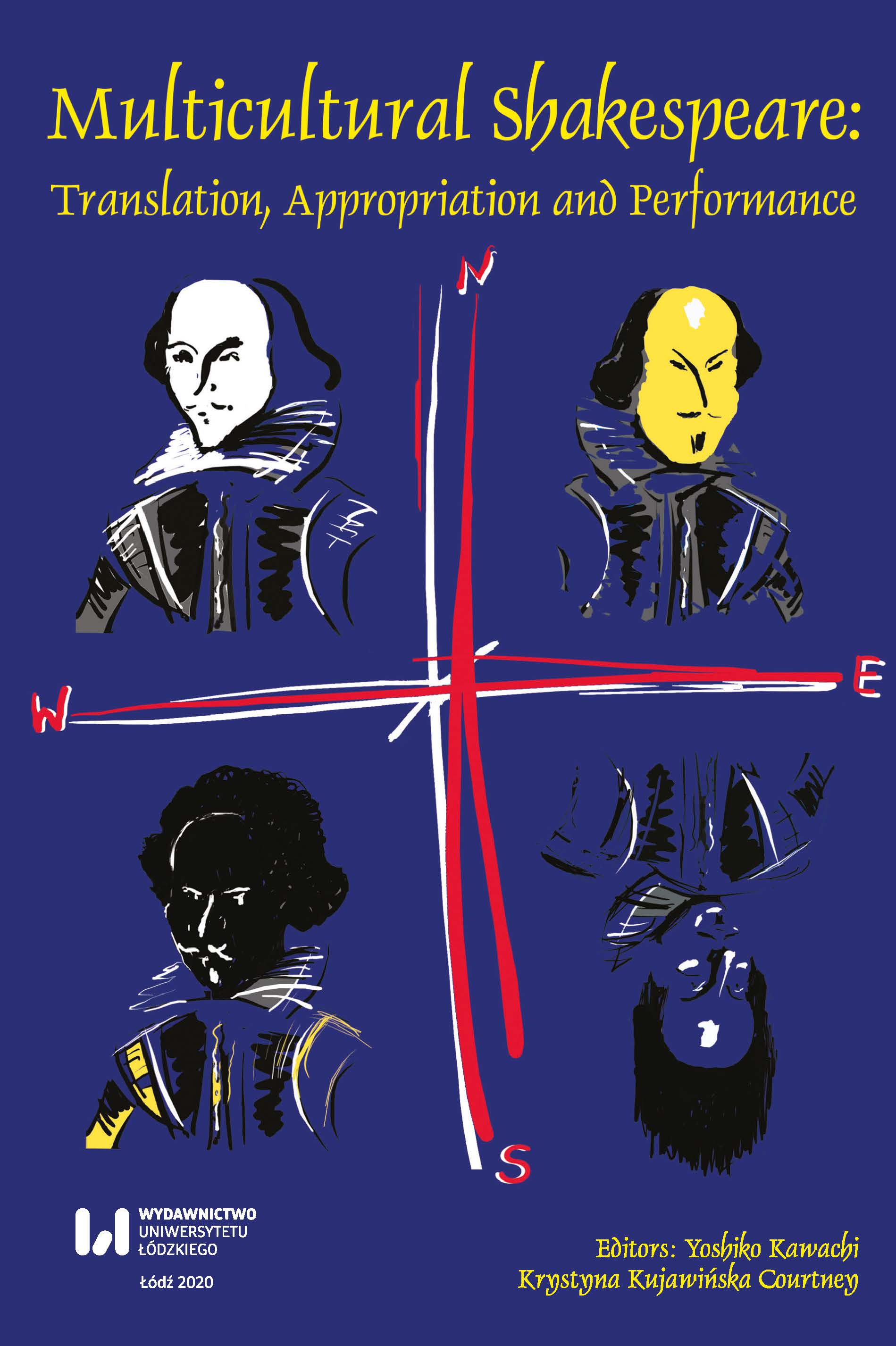Othello-dor: Racialized Odor In and On Othello
DOI:
https://doi.org/10.18778/2083-8530.22.03Keywords:
Shakespeare, Othello, scent, odor, blackness, blackface, performance, textiles, dyeing, costumingAbstract
For Shakespearean scholars, the subject of scent in his work has remained relatively lukewarm to discussion. Shakespeare’s use of smell is not only equal to that of his other senses, but smell’s uniquely historical record both on and off the stage illuminate his works in more ways than currently perceived. Shakespeare’s usage of smell is found throughout his works, and their importance on the late Elizabethan and early Jacobean stage present a playwright-director that was exceptionally in-tune with his audiences on the page and in person. Positioned at this culturally significant point in Shakespeare’s career, one work’s utilization of scent textually and theatrically fully explicates the importance of odor in a societal, racial, and domestic capacity: Othello. This article explores and establishes the importance of smell in relation to textual Othello, his “dyed in mummy” handkerchief, and Desdemona in the written tragedy. Additionally, it studies the heighted focus of smell in Othello on a metatheatric level for Shakespeare on his early modern stage, calling attention to the myriad of odors contained in and around his Renaissance theatre and the result effect this awareness would have had on his contemporary audiences in their experience of Othello as a uniquely smell-oriented show.
Downloads
References
“Audiences.” Globe Education. The Shakespeare Globe Trust, 2013, pp. 1-2.
Google Scholar
Bradbrook, M. C. Elizabethan Stage Conditions : A Study of Their Place in the Interpretation of Shakespeare’s Plays. Cambridge U. P., 1968.
Google Scholar
Bruster, Douglas. Drama and the Market in the Age of Shakespeare. Cambridge University Press, 1992, pp. 1, 86, 99.
Google Scholar
DOI: https://doi.org/10.1017/CBO9780511553080
Bruster. “The Dramatic Life of Objects in the Early Modern Theatre.” Staged Properties in Early Modern English Drama, edited by Jonathan Gil Harris and Natasha Korda, Cambridge UP, 2002, pp. 67-96.
Google Scholar
Corbin, Alain. The Foul and the Fragrant : The Social Discovery of Odor. Harvard University Press, 1986.
Google Scholar
Danielle Nagler. “Towards the Smell of Mortality: Shakespeare and Ideas of Smell 1588-1625.” The Cambridge Quarterly, no. 1, 1997, p. 42.
Google Scholar
DOI: https://doi.org/10.1093/camqtly/XXVI.1.42
Dannefeldt, Karl H. “Egyptian Mumia: The Sixteenth Century Experience and Debate.” The Sixteenth Century Journal, vol. 16, no. 2, 1985, p. 163-180.
Google Scholar
DOI: https://doi.org/10.2307/2540910
Dugan, Holly. “Scent of a Woman: Performing the Politics of Smell in Late Medieval and Early Modern England.” JOURNAL OF MEDIEVAL AND EARLY MODERN STUDIES, vol. 38, no. 2, pp. 229-252.
Google Scholar
DOI: https://doi.org/10.1215/10829636-2007-025
Findlay, Alison. Women in Shakespeare : A Dictionary. Continuum, 2010.
Google Scholar
Fineman, Joel. “Shakespeare’s Will: The Temporality of Rape.” Representations, no. 20, 1987, pp. 25-76.
Google Scholar
DOI: https://doi.org/10.2307/2928501
Hall, Edward. Henry VIII ed. Charles Whibley, T.C. and E.C. Jack, vol. 1, 1904, p. 16-17.
Google Scholar
Harris, Jonathan Gill. “The Smell of ‘Macbeth.’” Shakespeare Quarterly, no. 4, 2007, p. 465.
Google Scholar
DOI: https://doi.org/10.1353/shq.2007.0062
Henslowe, Philip. Documents of the Rose Playhouse. edited by Carol Chillington Rutter, Manchester University Press, 2000, p. 135.
Google Scholar
Holme, Randle. Academy of Armory edited by Menston, London Scholar Press, 1972, p. 64.
Google Scholar
Jonson, Ben, and T. G. S. Cain. Poetaster. Manchester University Press; Distributed in the USA and Canada by St. Martin’s Press, 1995.
Google Scholar
Lazzuri, Caryn. “What’s that smell? Getting personal with historic costumes.” The Collation: Research and Exploration at the Folger, Folger Shakespeare Library, 23 Oct. 2013.
Google Scholar
Linthicum, M. Channing. Costume in the Drama of Shakespeare and His Contemporaries. Hacker Art Books, 1972.
Google Scholar
Montserrat, Dominic. “Unidentified Human Remains: Mummies and the Erotics of Biography.” Changing Bodies, Changing Meanings: Studies on the Human Body in Antiquity edited by Dominic Montserrat, Routledge, 1998, pp. 168-169.
Google Scholar
Orgel, Stephen. The Authentic Shakespeare, and Other Problems of the Early Modern Stage. Routledge, 2002.
Google Scholar
Paulson, Michael. “Sounds Like a Musical, Smells Like Pie.” The New York Times, 27 Apr. 2016, p. C4.
Google Scholar
Platter, Thomas. “Thomas Platter, A Swiss Tourist in London.” The Norton Anthology of English Literature: The Romantic Age: Introduction, W. W. Norton and Company, www.wwnorton.com/college/english/nael/16century/topic_4/tplatter.htm
Google Scholar
Saunders, Ben. “Iago’s Clyster: Purgation, Anality, and the Civilizing Process.” Shakespeare Quarterly, vol. 55, no. 2, 2004, pp. 146-176.
Google Scholar
DOI: https://doi.org/10.1353/shq.2004.0073
Serpico, Margaret. “Resins, Amber and Bitumen.” Ancient Egyptian Materials and Technology, edited by Paul T. Nicholson and Ian Shaw, Cambridge Univ. Press, 2009, p. 468.
Google Scholar
Shakespeare, William. The Complete Works of Shakespeare. Edited by David Bevington. Scott, Foresman and Company, 1980.
Google Scholar
Shakespeare, William. The Tragedy of Othello: The Moor of Venice. Shakespeare: Four Great Tragedies. Edited by Alvin Kernan, Jr., Signet Classics Printing, 1998, pp. 1-133.
Google Scholar
Smith, Ian. “Othello’s Black Handkerchief.” Shakespeare Quarterly, vol. 64, no. 1, 2013, pp. 1-25.
Google Scholar
DOI: https://doi.org/10.1353/shq.2013.0017
Uhlman, Diana R. “…A Dyer…” Chaucer’s Pilgrims: An Historical Guide to the Pilgrims in The Canterbury Tales, edited by Laura C. Lambdin and Robert T. Lambdin, Praeger, 1996.
Google Scholar
Vaughan, Virginia Mason. Performing Blackness on English Stages, 1500-1800. Cambridge University Press, 2005.
Google Scholar
Witmore, Michael, narrator. “Sights, Sounds, and Smells of Elizabethan Theater.” Shakespeare Unlimited, episode 87, Folger Shakespeare Library, 13 Dec. 2017, https://www.folger.edu/shakespeare-unlimited/sights-sounds-smells-elizabethan-theater
Google Scholar
Yachnin, Paul. “Wonder-Effects: Othello’s Handkerchief.” Staged Properties in Early Modern English Drama, edited by Jonathan Gil Harris and Natasha Korda, Cambridge UP, 2002, pp. 316-334.
Google Scholar
Downloads
Published
How to Cite
Issue
Section
License

This work is licensed under a Creative Commons Attribution-NonCommercial-NoDerivatives 4.0 International License.












